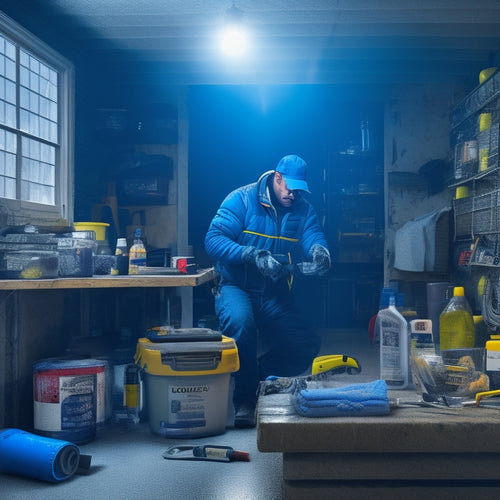
A 7-Step Guide to Buying and Setting Up a Solar Power Set
Share
You'll need to determine your daily energy needs, researching local policies and incentives along the way. Next, you'll choose the right solar panel type, considering factors like efficiency, durability, and cost. A compatible inverter is essential, and you'll need to select a suitable battery type that meets your energy storage needs. Prepare your installation site by evaluating ideal panel placement, local regulations, and potential shading obstacles. Then, assemble your solar power set, connecting components safely and efficiently. Finally, connect and test the system, ensuring ideal performance. As you maneuver through these steps, you'll uncover the complexities of creating a customized solar power set that meets your unique energy needs.
Key Takeaways
- Determine your daily energy needs by calculating the watt-hours consumed by your devices and adding a 10-20% buffer for energy losses.
- Choose the right solar panel type (monocrystalline, polycrystalline, thin-film, or bifacial) based on efficiency, durability, and cost.
- Select a compatible inverter (string, microinverter, or power optimizer) that matches your panel setup and has an efficiency above 95%.
- Consider battery capacity, voltage, and inverter compatibility when picking a suitable battery type, and ensure it's compatible with your system.
- Ensure a safe and efficient installation by assessing your site, verifying local regulations, and following manufacturer guidelines for assembly and testing.
Determine Your Energy Needs
To determine your energy needs, start by calculating your daily energy consumption in watt-hours (Wh). This involves identifying the devices you'll be powering with your solar setup and their respective energy requirements.
Make a list of these devices, including their wattage ratings and the number of hours you'll use them daily. Multiply the wattage by the usage hours to get the daily Wh consumption for each device. Add up the total Wh consumption to get your daily energy needs.
Next, perform an efficiency assessment to account for energy losses during transmission and storage. You'll need to evaluate the efficiency of your solar panels, charge controller, battery, and inverter.
A general rule of thumb is to add 10-20% to your total daily energy needs to compensate for these losses.
With your adjusted daily energy needs, you can now determine the size of your solar panel array and battery bank. This will guarantee you have a solar power set that can meet your energy demands reliably.
Choose the Right Solar Panel
With your energy needs determined, you're now ready to select the right solar panel for your off-grid setup. There are several solar panel types to evaluate, each with its own advantages and disadvantages. To make an informed decision, let's investigate the key differences between them.
| Solar Panel Type | Installation Cost |
| Monocrystalline | $2.50 - $3.50 per watt |
| Polycrystalline | $2.00 - $3.00 per watt |
| Thin-Film | $1.50 - $2.50 per watt |
| Bifacial | $2.25 - $3.25 per watt |
When choosing a solar panel, assess factors such as efficiency, durability, and cost. Monocrystalline panels offer high efficiency but come at a higher cost. Polycrystalline panels are a more affordable option with slightly lower efficiency. Thin-Film panels are the most budget-friendly but have lower efficiency. Bifacial panels offer higher energy output but are more expensive. Reflect on your energy needs, budget, and installation constraints to select the best solar panel for your off-grid setup.
Select a Compatible Inverter
Your solar panel selection is now complete, and it's time to focus on the inverter, an essential component that converts the DC power generated by your solar panel into AC power for your off-grid setup.
When selecting an inverter, you'll need to take into account inverter types and inverter efficiency. There are three main inverter types: string inverters, microinverters, and power optimizers.
String inverters are the most common and cost-effective option, but may not be suitable for systems with multiple panels of different sizes or orientations. Microinverters, on the other hand, are more expensive but offer greater flexibility and monitoring capabilities. Power optimizers provide a compromise between the two.
Inverter efficiency is also vital, as it directly affects the amount of usable energy your system produces. Look for an inverter with a high efficiency rating, typically above 95%.
A higher efficiency rating means more of the DC power generated by your solar panel is converted into usable AC power. By choosing the right inverter for your system, you'll guarantee maximum energy production and a reliable off-grid setup.
Pick a Suitable Battery Type
You'll need to choose a battery that meets your solar power system's specific requirements, taking into account factors such as capacity, voltage, and compatibility with your inverter.
When selecting a suitable battery type, you'll want to evaluate criteria like depth of discharge, round-trip efficiency, and lifespan.
Deep cycle batteries, designed to withstand frequent charging and discharging, are a popular option for solar power systems.
Battery Selection Criteria
Selecting the right battery type for your solar power set is crucial, as it directly impacts the system's overall performance, reliability, and cost.
You'll want to take into account several key factors to guarantee you get a battery that meets your needs.
When evaluating battery options, take into account the following criteria:
-
Battery Lifespan: Look for batteries with a long lifespan to minimize replacement costs and reduce waste. A longer lifespan also means you'll get more value from your investment.
-
Charging Efficiency: A battery with high charging efficiency will waste less energy during charging, reducing your overall energy costs.
-
Depth of Discharge (DOD): A battery's DOD indicates how much of its capacity can be safely used without damaging the battery. A higher DOD means you can use more of the battery's capacity.
- Operating Temperature Range: Verify the battery can operate within the temperature range of your installation site to guarantee reliable performance.
Deep Cycle Options
When it comes to battery selection, deep cycle options emerge as a popular choice for solar power systems.
You'll find two main battery types: flooded and sealed. Flooded batteries require regular maintenance, such as checking electrolyte levels and adding water, whereas sealed batteries are maintenance-free. Consider your maintenance requirements when deciding between the two.
Deep cycle batteries are designed to provide a steady flow of energy over a prolonged period. They've a longer cycle life, meaning they can withstand more charge and discharge cycles.
Look for batteries with a high cycle life, typically above 500 cycles, to guarantee your solar power system remains efficient.
Charging methods and discharge rates also impact battery performance. Be certain to choose a battery that can handle your system's charging method, whether it's a solar charger, wind turbine, or grid tie inverter.
Additionally, consider temperature effects, as high temperatures can reduce battery life. Research different brands, comparing their specifications and warranties to find the best deep cycle battery for your solar power set.
Prepare Your Installation Site
You'll need to conduct a thorough site assessment to guarantee your solar power set is installed in an ideal location.
Before you begin, check with your local authorities to determine if any regulations or permits are required for your installation.
Clear the area around your installation site of any debris or obstructions to guarantee a safe and efficient setup process.
Site Assessment Needed
Before installing your solar power set, it's vital to assess your installation site to confirm ideal energy harvesting. You want to verify your solar panels receive maximum sunlight exposure to enhance energy production.
To achieve this, consider the following solar site considerations:
-
Shading: Identify any obstacles that may cast shade on your solar panels, such as trees, buildings, or chimneys. Shading can noticeably reduce energy output, so it's important to choose a site with minimal shading.
-
Orientation: Determine the best orientation for your solar panels to capture sunlight. In the northern hemisphere, a south-facing orientation is ideal.
-
Slope: Assess the slope of your roof or installation site. A slope of 30-40 degrees is recommended for maximum energy harvesting.
- Obstructions: Check for any obstructions, such as vents, skylights, or antennas, that may interfere with your solar panel installation.
Check Local Regulations
Now that you've assessed your site to guarantee ideal energy harvesting, prepare your installation site by checking local regulations. This vital step assures you're compliant with local authorities and takes advantage of available incentives.
Research local building codes, permits, and zoning restrictions that might impact your solar power setup. Familiarize yourself with your local government's policies on solar installations, including any necessary permits or licenses.
Additionally, investigate local incentives that can help offset the cost of your solar power system. Many governments offer rebates, tax credits, or other benefits for homeowners who invest in renewable energy. Knowing what incentives are available can help you maximize your investment.
Be sure to also review your neighborhood's covenants, conditions, and restrictions (CC&Rs), if applicable, to guarantee your solar installation complies with them.
Clear The Area
As you prepare to install your solar power system, clearing the area around your installation site is crucial to guarantee a smooth and efficient process.
You'll want to make sure that the area is free from any obstacles that could hinder the installation or impact the performance of your solar panels.
Before you begin, take a closer look at your installation site and remove or trim any obstructions that could affect solar panel placement or create shading considerations.
Here's what to check for:
-
Trees and branches: Trim or remove any trees or branches that could cast a shadow on your solar panels, reducing their energy output.
-
Roof debris: Clear your roof of debris, such as leaves, twigs, or broken tiles, to make certain a safe and secure installation.
-
Power lines and antennas: Verify that there are no power lines or antennas in the vicinity that could interfere with your solar power system.
- Ventilation and skylights: Check for any ventilation systems, skylights, or other roof features that could impact solar panel placement or installation.
Assemble the Solar Power Set
With your solar power set unpacked and all components accounted for, begin by identifying the main components, including the solar panel, charge controller, battery, and inverter. These components will work together to provide you with a reliable source of renewable energy.
Next, focus on assembling the solar panel. This involves securing the panel to a mounting system, which may include a roof mount, pole mount, or tracking system. Make sure the panel is securely fastened and angled for maximum energy absorption.
| Component | Connection |
|---|---|
| Solar Panel | Connect to charge controller |
| Charge Controller | Connect to battery and solar panel |
| Battery | Connect to inverter and charge controller |
| Inverter | Connect to battery and electrical load |
When making wiring connections, be certain to follow the manufacturer's instructions and take necessary safety precautions to avoid electrical shock. Properly securing wiring connections is essential to guarantee the system operates efficiently and safely.
Connect and Test the System
You've completed the assembly of your solar power set; the next step is to connect and test the system. This vital step guarantees that all components work harmoniously, providing you with a reliable source of renewable energy.
To connect and test the system, follow these essential steps:
-
Verify system compatibility: Confirm that all components, including the solar panels, charge controller, battery, and inverter, are compatible with each other.
-
Connect the solar panels: Securely connect the solar panels to the charge controller, making sure to follow the manufacturer's instructions.
-
Link the battery and inverter: Connect the battery to the inverter, ensuring a safe and efficient energy flow.
- Activate the system and monitor performance: Turn on the system and monitor its performance, checking for any signs of malfunction or error.
Remember to prioritize safety protocols during this process, taking necessary precautions to avoid electrical shock or other hazards.
Monitor and Maintain Performance
Having verified your solar power set is functioning correctly, now it's important to monitor and maintain its performance to optimize energy output and prolong its lifespan.
Performance monitoring involves tracking your system's efficiency and identifying areas for improvement. You'll want to implement routine inspections to detect any potential issues before they escalate. Develop troubleshooting techniques to address common problems, such as faulty inverters or dirty panels.
To optimize system performance, you'll need to track data on energy production, consumption, and storage. Data logging tools can help you analyze performance analytics and identify trends.
Create a maintenance schedule to guarantee regular checks and replacements of components as needed. This proactive approach will help you stay on top of your system's performance and make adjustments to maximize energy output.
Frequently Asked Questions
Can I Install Solar Panels on a Metal or Clay Tile Roof?
You'll face unique installation challenges on a metal or clay tile roof, but it's not impossible; assess roof suitability by evaluating tile type, condition, and structural integrity to guarantee a secure and efficient solar panel installation.
Are Solar Power Systems Resistant to Extreme Weather Conditions?
You'll be relieved to know that solar power systems are built to withstand harsh weather conditions, offering weather durability and storm protection, ensuring your system remains functional and secure even in extreme winds, heavy rains, and scorching heat.
Do I Need a Permit to Install a Solar Power System?
You'll likely need a permit to install a solar power system, as solar installation regulations vary by region; you'll need to maneuver through the permit application process, ensuring compliance with local building codes and electrical standards.
Can I Expand My Solar Power System in the Future?
Like a skilled architect adding wings to a grand estate, you'll find that your solar power system is designed to accommodate future expansion, allowing you to scale up with system upgrades as your energy needs evolve.
Are Solar Power Systems Compatible With All Electrical Appliances?
You'll find that most solar power systems are compatible with standard electrical appliances, but it's essential to contemplate solar appliance compatibility and energy efficiency concerns to guarantee seamless integration and peak performance.
Conclusion
You've successfully set up your solar power set! Now, enjoy the benefits of renewable energy and reduced electricity bills. Did you know that solar power can save up to 75% of your energy costs? With the right setup and maintenance, you'll be utilizing the sun's energy in no time. Remember to regularly monitor your system's performance to guarantee peak energy collection. With the rising demand for clean energy, you're contributing to a sustainable future - and that's something to feel proud of!
Related Posts
-

Waterproofing Solar Panels for Vehicles: A Step-by-Step Guide
When waterproofing solar panels for your vehicle, start by evaluating your energy requirements and selecting the righ...
-

Why Go Green With Automotive Products Online?
By switching to eco-friendly automotive products online, you're taking a significant step towards reducing your carbo...
-

Top Online Stores for Solar Car Accessories
When searching online for solar car accessories, you'll find top retailers like Amazon, REI Co-op, and Best Buy offer...


